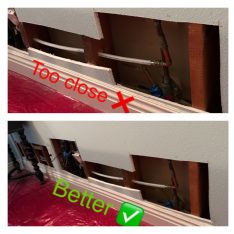How to Properly Prime and Paint a Drywall Patch: A Step-by-Step Guide
If you've ever had to repair a hole or crack in your drywall, you know that getting the finish to look as good as new can be a bit of a challenge. The key to a seamless repair is proper priming and painting. In this guide, we'll walk you through the steps to ensure your drywall patch blends perfectly with the rest of your wall.
Step 1: Preparing the Surface
Before you can prime and paint, you need to make sure the drywall patch is properly prepared.
- Allow the Patch to Dry: If you’ve used joint compound to fill the hole, ensure it’s completely dry before you start. Drying time depends on the size of the patch and the product used. Cold or rainy weather can also prolong drying conditions. Follow the suggested dry times on brand labels or ask your contractor when you can paint.
Step 2: Priming the Patch
Priming is crucial as it seals the drywall patch and helps the paint adhere properly.
- Choose the Right Primer: Use a high-quality drywall primer or a primer-sealer. These are specifically designed to cover and seal new drywall patches.
- Apply the Primer: Use a brush or roller to apply a thin, even coat of primer over the patched area. Be sure to extend the primer slightly beyond the edges of the patch to blend it with the surrounding wall.
- Let it Dry: Follow the manufacturer's instructions for drying times. Usually, primer needs to dry for at least 1-2 hours before you can paint over it.
Step 3: Painting the Patch
Once the primer is dry, you can start painting.
- Choose the Right Paint: For best results, use the same type of paint (e.g., latex or oil-based) and finish (e.g., matte, eggshell, or satin) as the existing wall paint.
- Apply the First Coat: Using a paintbrush or roller, apply the first coat of paint over the primed patch. Blend the paint out onto the surrounding wall to help with color consistency.
- Feather the Edges: To avoid noticeable lines, feather the edges of the paint as you work. This means gradually blending the new paint into the old paint.
- Let it Dry: Allow the first coat to dry completely. Depending on the paint type, this could take a few hours.
- Apply Additional Coats: Check the patched area once the first coat is dry. You may need to apply a second or even third coat to achieve full coverage and match the existing wall.
- Touch Up as Needed: Once the final coat is dry, inspect the area for any imperfections. Touch up any spots that need extra attention.
Step 4: Clean Up
After the paint has dried completely, clean up your tools and dispose of any used materials.
- Wash Brushes/Rollers: If you used latex paint, clean your brushes and rollers with soap and water. For oil-based paints, use paint thinner or mineral spirits.
- Remove Painter’s Tape: Carefully remove any painter's tape you used to protect adjacent areas.
- Inspect Your Work: Finally, give your work a once-over to ensure everything looks seamless and tidy.
Tips for a Perfect Finish
- Match the Texture: If your wall has a specific texture (e.g., knockdown or stipple), you might need to replicate this texture on the patched area before painting. You can use tools like texture brushes or sponges for this purpose.
- Use Quality Materials: Invest in good quality primer and paint. They often provide better coverage and durability.
- Consider Lighting: Different lighting conditions can affect how well your paint job blends. Check your work under various lighting to ensure the patch is seamless.
By following these steps, you'll be able to achieve a professional-looking finish that makes your drywall patch virtually invisible. Happy painting!
